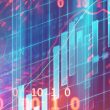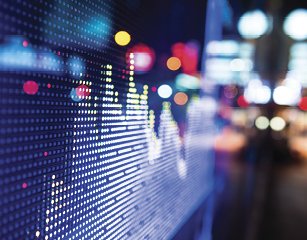by Jurrien Timmer, Director of Global Macro for Fidelity Management & Research Company
As much as I think of myself as a road cyclist through-and-through (as I am gearing up for my 27th PMC), I have recently found a new passion: swimming. Growing up in Aruba I have always felt at home in the water, and now that I am in my sixties I am finding that swimming (40 laps in a 25m pool, or 1k per day) is the perfect blend of zero-impact cardio, strength training, stretching, and breath work. It’s like yoga but in the water, or cycling without the tortured posture or road hazards. Of course, finding a pool or ocean nearby (that isn’t freezing) is a challenge, but for the time being I am having some success challenging my inner Kirk Douglas in “The Swimmer” (a great but somber movie about American post-war culture).
My new swim practice is a reminder that there are alternatives to old routines. For investing, that is truer today than it has been for some time. Just a few years ago US equities were the only game in town. TINA, or “There Is No Alternative,” was the mantra, with cash yielding zero and bonds yielding 1% and non-US equities left for dead.
But those days could well be over. Are we in a new era of TAMA (There Are Many Alternatives)? Cash is yielding more than 4%, bonds are yielding 4.5% (well above the inflation rate), international equities are not only cheap but sporting positive earnings momentum, and the status of the dollar as the hegemonic global reserve currency is in doubt. And gold and Bitcoin are proving their worth once again, as are other alts. All of a sudden, there are many items on the menu, which as a foodie is a good thing!
Welcome back bull?
With the S&P 500 now 23% above its April 7th low of 4827 (which produced a 21.5% drawdown from the February 19th peak), it’s almost as if nothing happened (assuming you took a 6-week nap). The index is now back on its trendline along the cyclical bull market path that started in October 2022.

We have no way of knowing whether the old bull is still alive or whether a new cycle is underway. With the index only 3% below its all-time high, we will know soon enough. My sense remains that we are in for a prolonged trading range, in which positive but modest earnings growth will be offset by falling P/E multiples driven by higher bond yields.
V-shaped
For now, the recovery has been as impressive as the one following that 20% drawdown in the fourth quarter of 2018. That’s the pink line below. I certainly didn’t have a V-shaped recovery on my bingo card a few weeks ago when both the bond and stock markets were being stress-tested. But the markets won and the Put was exercised. It was not a 2018-style Fed put this time, but a put is a put.

From fear to complacency
Even after 4 decades in the markets I remain impressed by how quickly the market can lurch from complacency to fear and back to complacency. Now that the markets have walked back from the abyss, the VIX has declined from 60 to 17, high yield spreads have narrowed from 453 bps to 305 bps, and the implied equity risk premium (iERP) has declined from 410 bps to 342 bps.

Do you want to be long or short this chart?
With the markets repricing from animal spirits in February to near-recession in April to now a modest slowdown, the S&P 500 is back on-trend. Now the question is whether the V takes us to new highs or whether we are in the early innings of a prolonged range, not unlike 2018 and 2015 below. That certainly wouldn’t be the end of the world after two very robust years.

Slowdown or worse?
GDP estimates for the coming quarters all call for a slowdown in growth, but nothing worse. If it does become worse, it seems that the stock market is over its skis at a 21x forward P/E.

Earnings: priced for a slowdown
With GDP estimates coming down, it’s no surprise that earnings estimates are being cut as well. While Q1 earnings season was very strong, the growth rates for the coming three quarters have been cut by 300-400 bps. The pattern is clear: estimates drift lower as we approach earnings season, and then bounce higher as companies under-promise and over-deliver. The question is how that trajectory compares to the typical pattern.

2025: priced for average
For calendar year 2025 we see that the growth rate has been cut from 12.4% to 7.4%. That isn’t too far out of line with the typical pattern, but you can see a noticeable dip in recent weeks. My conclusion is that the market is now priced for a slowdown but nothing worse. With the fwd P/E multiple bouncing from 18x to 21x, it better be right.

Mag7: priced for imperfection
How about those market bellwethers the Mag 7? They are back at a 30x multiple (up from 25x), while their earnings momentum seems to be stalling out. Both the 2026 and 2027 estimates are now declining, which is a departure from recent years.

Nifty Fifty
As I have posited in recent months, one of the big questions hanging over the market is whether the leadership baton can be passed from the mega growers to the rest of the market without impairing the index as a whole. It remains a question without an answer, but it’s encouraging that at 30x the Mag 7 are not sporting the kind of bubble valuations that past Nifty 50 regimes produced. Back in 1974 and again in 2000, the Nifty Fifty were trading at 2x the rest of the market. Today it’s more like 30-40%.
Nevertheless, the US equity market remains near peak valuations, with the 5-year CAPE ratio at 30.7x and the implied ERP at 3.5%. With the market trading in its top decile of historical valuations, some mean-reversion in the coming years seems likely.

RoW
Meanwhile, after being left for dead for many years, the rest of the world (MSCI ACWI ex-US) is edging closer to new highs, while trading at a 14.9x forward multiple. A potential secular mean-reversion between US large cap growth and everything else remains a high stakes opportunity.

The USD
A big part of the above equation will rest on the fate of the US dollar. Will it lose its hegemonic supremacy now that the global world order is potentially changing to a more mercantilist and de-dollarized regime? After a sharp drop earlier this year, the dollar is back in the range, so for now the trend is inconclusive.

Peak hegemony
Was the simultaneous drawdown last month in the stock market, bond market, and dollar, a taste of things to come, where all US assets lose their dominance? If so, a weakening dollar coupled with peak US valuations could produce strong tailwinds for the global mean-reversion trade.

Rates nearing the danger zone
With the S&P 500 recovering most of its decline, little noticed has been the long end of the Treasury market, which is once again nearing the danger zone of 4.5-5.0% (10-year) as the term premium reaches a new cycle high of 74 bps. There’s an old saying that “nothing good ever happens after midnight” and we could borrow that phrase and say that nothing good happens above a 5% yield. It’s my strong hunch that the next chapter in this market cycle will be driven by rates, as term premia return to their historical pre-QE levels.

The Fed model rules again
Tariffs or no tariffs, DOGE or no DOGE, deficits have not been repealed. In my view, we remain in the post-COVID regime where yields are driving the bus and the Fed model is in charge. The Fed model, favored by Alan Greenspan during the 1980’s, compares the equity P/E to the bond “P/E” (inverse of yield). Whenever bond yields become too competitive with equities (as their yield rises), ultimately the stock market would need to reprice. The most famous example of this was the 1987 crash.

The model didn’t work during the financial repression days of the 1940’s and 2000’s, but it reigned supreme from the 1960’s through the 1990’s. By definition, it works best when bonds are positively correlated to stocks. Given that long bonds yielding close to 5% are now once again competitive with equities (also yielding 5%), I suspect that the Fed model will continue to dominate.
Below we see a scatter plot of the bond P/E (x) and the equity P/E (y). The purple dots show the entire history (1926-2025) and the orange line shows the four-decades period when the Fed model ruled. Higher bond yields produce higher equity yields, along a tight logarithmic trendline. The black line is the 2022-2025 period. The orange line suggests that if the 10-year moves back up to 5% (as it did in October 2023), the equity P/E could fall 4 points to 17-18x.

To put some perspective around this, a 4 point P/E drop would suggest a price drop of 15-20% before accounting for the earnings growth offset of 5-10%. So, I am guessing that a 3-4 point P/E derating would produce a 10% drop in the S&P 500.
TAMA (There Are More Alternatives)
Now that the menu of investment choices is growing again, how should we think about the 60/40 model? Back in the day (late 1990’s until 2022) all you needed was a two asset portfolio (S&P 500 and Bloomberg Agg) and you earned a 9% CAGR with a 9% vol. Pretty good.
But in my view, with US valuations rich and the term premium headed higher, it makes more sense to paint the 60/40 model with a broader brush, consisting (of course) of equities (but with more international), bonds (but fewer than before), and that broad bucket of alternatives. For me, the old 60/40 is now a 60/20/20, with the last 20 consisting of some mix of liquid and semi-liquid alts, gold, Bitcoin, and cash.

Are we hedging the 60 or the 40?
We are used to thinking about the 40 as the hedge against the 60, with equities as the portfolio anchor and bonds providing the insurance policy. But if bonds are also at risk, perhaps we should focus on how to hedge against the 40 as well. If per the Fed model it will be rising bond yields that cause indigestion for equities, then we want to hedge against both the 40 and the 60 at the same time.
Below we see the 5-year correlation (of weekly returns) against the S&P 500 index and against the Bloomberg long-term Treasury index. What we are looking for are assets that have a negative or low correlation to both. These include liquid alts such as hedged equity, absolute return, and managed futures, and other assets like gold, cash, and Bitcoin.

This information is provided for educational purposes only and is not a recommendation or an offer or solicitation to buy or sell any security or for any investment advisory service. The views expressed are as of the date indicated, based on the information available at that time, and may change based on market or other conditions. Opinions discussed are those of the individual contributor, are subject to change, and do not necessarily represent the views of Fidelity. Fidelity does not assume any duty to update any of the information.
Copyright © Fidelity Management & Research Company
















